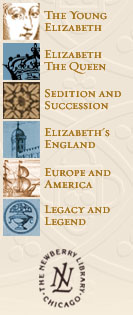 |

The Succession Question

From the beginning of her reign, Elizabeth's Council and Parliament begged her to choose a successor, fearing chaos if she died without an heir. There was a range of candidates, most of whom were descended from the sisters of Henry VIII. But Elizabeth always refused to name an heir. She feared that any successor would be a focus for discontent and rebellion, just as she had been before coming to the throne. But after all the plots and fears, when Elizabeth died in March 1603, there was a clear consensus in favor of James VI of Scotland. Although Elizabeth had executed Mary Queen of Scots for attempting to assassinate her, it was Mary's son James who in the end peacefully inherited the throne of England.
Return to Sedition and Succession
|  |



